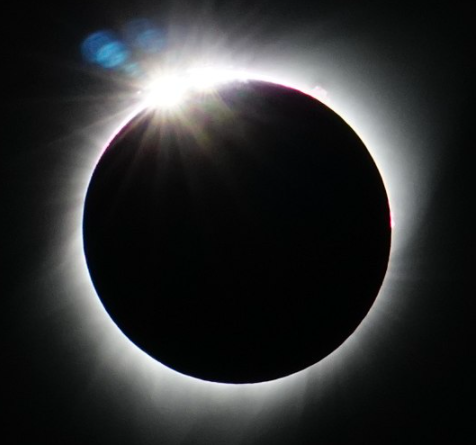
Diamond rings occur in which type of solar eclipse?
(a) total solar eclipse
(b) partial solar eclipse
(c) None of these
Answer
432.9k+ views
Hint: In the given question, to know the type of solar eclipse in which diamond rings occur, we should go through the whole concept of Baily’s beads, in which we will come to know the type of solar eclipse.
Complete answer:
The Baily’s beads effect, or Diamond ring effect, is a feature of total and annular solar eclipses. There are four types of solar eclipses: total, partial, annual and hybrid. Total solar eclipses happen when the sun is completely blocked by the moon. During a total solar eclipse, at the beginning and end of the totality the diamond ring effect occurs.
The Baily's beads effect or diamond ring effect is a feature of total and annular solar eclipses. As the Moon covers the Sun during a sun powered obscuration, the rough geography of the lunar appendage permits dabs of daylight to radiate through in certain spots while not in others. The impact is named after Francis Baily, who clarified the wonder in 1836. The precious stone ring impact is seen when just one globule is left, showing up as a sparkling "jewel" set in a brilliant ring around the lunar outline.
Image showing the diamond rings formed during a solar eclipse:

Hence, the correct option is (A).
Note:
It is a component of aggregate and annular sun oriented shrouds. As the Moon covers the Sun during a sun powered obscuration, the rough geology of the lunar appendage permits globules of daylight to radiate through in certain spots while not in others.
Complete answer:
The Baily’s beads effect, or Diamond ring effect, is a feature of total and annular solar eclipses. There are four types of solar eclipses: total, partial, annual and hybrid. Total solar eclipses happen when the sun is completely blocked by the moon. During a total solar eclipse, at the beginning and end of the totality the diamond ring effect occurs.
The Baily's beads effect or diamond ring effect is a feature of total and annular solar eclipses. As the Moon covers the Sun during a sun powered obscuration, the rough geography of the lunar appendage permits dabs of daylight to radiate through in certain spots while not in others. The impact is named after Francis Baily, who clarified the wonder in 1836. The precious stone ring impact is seen when just one globule is left, showing up as a sparkling "jewel" set in a brilliant ring around the lunar outline.
Image showing the diamond rings formed during a solar eclipse:

Hence, the correct option is (A).
Note:
It is a component of aggregate and annular sun oriented shrouds. As the Moon covers the Sun during a sun powered obscuration, the rough geology of the lunar appendage permits globules of daylight to radiate through in certain spots while not in others.
Recently Updated Pages
Express the following as a fraction and simplify a class 7 maths CBSE

The length and width of a rectangle are in ratio of class 7 maths CBSE

The ratio of the income to the expenditure of a family class 7 maths CBSE

How do you write 025 million in scientific notatio class 7 maths CBSE

How do you convert 295 meters per second to kilometers class 7 maths CBSE

Write the following in Roman numerals 25819 class 7 maths CBSE

Trending doubts
Full Form of IASDMIPSIFSIRSPOLICE class 7 social science CBSE

What does R mean in math class 7 maths CBSE

How many crores make 10 million class 7 maths CBSE

Fill in the blanks with appropriate modals a Drivers class 7 english CBSE

The southernmost point of the Indian mainland is known class 7 social studies CBSE

Convert 200 Million dollars in rupees class 7 maths CBSE





